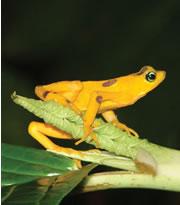 The Panamanian golden frog is one of about 110 species of harlequin frog, many of which are dying out.© Forrest Brem
The Panamanian golden frog is one of about 110 species of harlequin frog, many of which are dying out.© Forrest BremThe mysterious disappearance of frog species throughout Central and South America has been linked to a fungal disease that is exacerbated by the changing climate.
"Disease is the bullet killing frogs, but climate change is pulling the trigger," says Alan Pounds, an ecologist at the Monteverde Cloud Forest Preserve and Tropical Science Center in Costa Rica.
Researchers warn that the fungus Batrachochytrium dendrobatidis, which lives on the frogs' skin, may be killing amphibians worldwide.
Tropical America is just one of many regions that have seen dramatic losses of amphibian species over the past few decades. In 2004, the first global assessment of amphibians revealed that almost a third of the world's known species are threatened with extinction1.
Studies have pointed to a range of causes for these deaths, including infections, habitat loss and changing temperature or rain patterns; amphibians, with their moist, breathable skins, are thought to be particularly sensitive to environmental change. But the root of the problem in many places, often in seemingly pristine habitats, has remained elusive.
First to go
“We have to reduce concentrations of greenhouse gases very soon if we are to avoid massive losses of biodiversity.”
Alan Pounds
Monteverde Cloud Forest Preserve, Costa Rica.
Pounds and his team set out to test whether fungal disease exacerbated by climate change could explain the loss of 70 or so species of harlequin frog (Atelopus) from the highlands of Central and South America. Many of them have vanished despite being in protected reserves.
The team first mapped the timing of species disappearances against changes in sea-surface and air temperature over the past few decades, and found that the frogs are disappearing almost exactly in step with climate change.
But it was not clear how the link between species loss and climate change worked: the world is generally warming, but the fungus is thought to be more deadly in cooler climes.
So the team looked at 50 sites from Costa Rica to Peru. It found that the frogs were doing worst in areas where night-time temperatures are getting warmer, but day-time temperatures are cooler - conditions that favour the fungus.
The most likely connection, say the researchers in Nature2, is that large-scale warming is accelerating the formation of clouds. This in turn makes local conditions kinder on the fungus, and spells bad news for the frogs.
Cause for alarm
ADVERTISEMENT
The extent to which the team's finding explains the global problem of amphibian deaths is not yet clear. But Pounds argues that because the chytrid fungus is known to exist in many regions, including Europe and Australia, "it is likely to be a key player on a global scale". Of course, it is still uncertain how global climate change will affect local weather patterns where frogs and toads live.
Camille Parmesan, an ecologist at the University of Texas, Austin, and an author of the third assessment report of the Intergovernmental Panel on Climate Change, applauds the study. She says it is "the first to show a whole group of extreme-environment species disappearing because of climate change on a large scale".
Pounds hopes his team's findings will ram home the global-warming message. "We have to reduce concentrations of greenhouse gases very soon if we are to avoid massive losses of biodiversity."
Monteverde Cloud Forest Preserve, Costa Rica.
